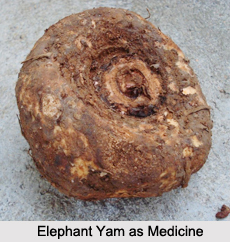 Amorphophallus campanulatus, commonly known as Elephant Yam is cultivated for the sake of its tubers, which are cooked and eaten by the natives like yams or potatoes. The tubers contain an acrid juice which should be get rid off by thorough boiling and washing, otherwise the vegetable is apt to cause troublesome irritation in the mouth and fauces.
Amorphophallus campanulatus, commonly known as Elephant Yam is cultivated for the sake of its tubers, which are cooked and eaten by the natives like yams or potatoes. The tubers contain an acrid juice which should be get rid off by thorough boiling and washing, otherwise the vegetable is apt to cause troublesome irritation in the mouth and fauces.
Benefits of Elephant Yam
Medicinally, Elephant Yam is considered serviceable in hemorrhoids; in fact one of its Sanskrit synonyms is "Arsoghna" or the curer of piles. It is administered in this disease in a variety of forms. The tuber is covered with a layer of earth and roasted in a fire; the roasted vegetable is given with the addition of oil and salt.
Dose of Elephant Yam in Medicine
Several confections are described such as the Laghu surana modaka, Vrihat surana modaka, Surana pindi, Kankayana modaka, etc. These are all confections made of the tubers of Amorphophallus campanulatus with the addition of treacle and various aromatics and acrids.
Svalpa or Laghu surana modaka is thus prepared by taking black pepper 1 part, ginger 2 parts, plumbago root 4 parts, tuber of elephant yam 8 parts, treacle 16 parts, mix together and prepare a confection. Dose should be about a tola every morning, in piles and dyspepsia.
This article is a stub. You can enrich by adding more information to it. Send your Write Up to content@indianetzone.com




















